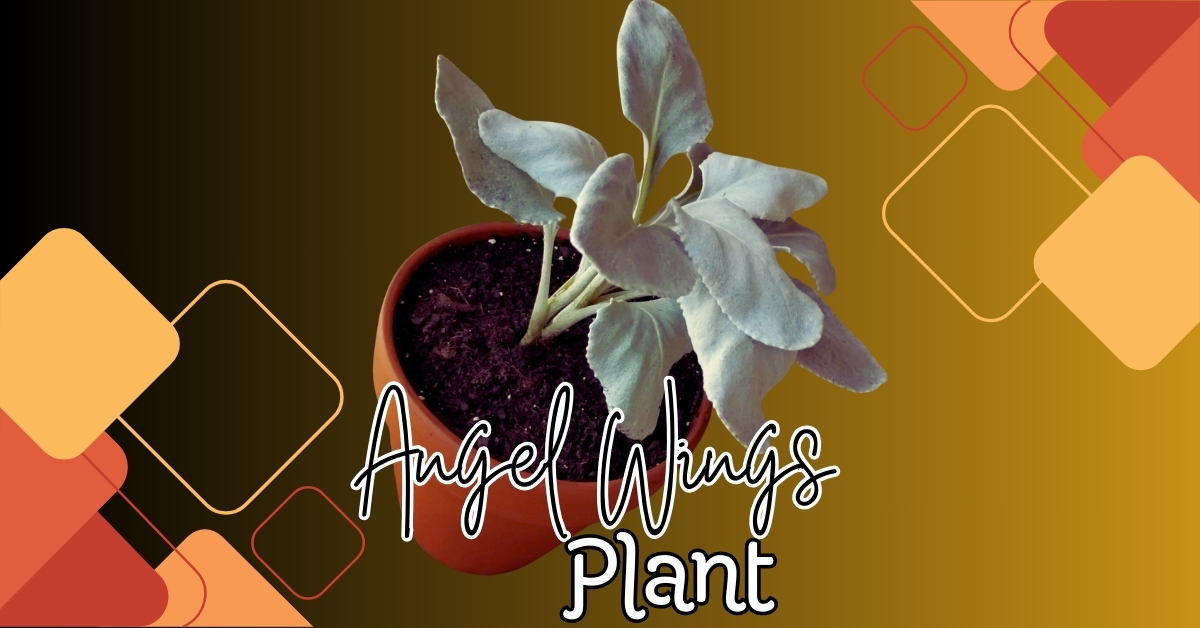Angel Wing Begonias are a stunning addition to any indoor or outdoor garden. With their distinctive wing-shaped leaves and vibrant blooms, they bring a tropical feel to any space. But like all plants, they need proper care to thrive. If you’re a new or seasoned plant enthusiast wondering how to grow this beautiful plant, you’re in the right place. In this post, we’ll provide 5 essential tips for Angel Wing Begonia care, covering everything from light requirements to watering practices, and much more.
What Is Angel Wing Begonia? A Guide to Its Origins and Appearance
Angel Wing Begonia (Begonia coccinea) is a species of begonia that’s native to South America. It earned its name because of its unique, asymmetrical leaves, which resemble the shape of angel wings. The leaves are typically green with silver or white speckles on the surface, while the undersides are often a deep red or burgundy.
Angel Wing Begonias are popular not only for their foliage but also for their bright, showy blooms, which range from red and pink to orange and white. These flowers usually appear in clusters and can last throughout the summer if the plant is well cared for.
This begonia can be grown both indoors and outdoors, depending on the climate, and it’s known for being a relatively easy plant to maintain, provided you meet its basic care requirements.
Angel Wing Begonia Light Requirements
One of the key factors in growing healthy Angel Wing Begonias is providing the right amount of light. These plants thrive in bright, indirect light, similar to the conditions found in their native tropical habitats. Here’s what you need to know about light requirements:
- Indoor Light: If you’re growing Angel Wing Begonias indoors, place them near a window with filtered sunlight. East-facing or north-facing windows are ideal because they provide soft morning light without the intense heat of direct afternoon sun.
- Outdoor Light: Outdoors, Angel Wing Begonias prefer dappled sunlight or partial shade. Too much direct sunlight can scorch the leaves, causing them to dry out and turn brown.
- Signs of Light Stress: If your Angel Wing Begonia isn’t getting enough light, you might notice the leaves become pale or leggy, indicating that the plant is stretching toward the light. On the other hand, if it’s receiving too much direct sun, the leaves may become scorched.
In summary, bright but indirect light is key to ensuring your Angel Wing Begonia stays healthy and produces vibrant blooms.
Watering Angel Wing Begonia: Best Practices
Proper watering is critical to the health of your Angel Wing Begonia. While the plant enjoys moisture, it doesn’t like to sit in water. Overwatering can lead to root rot, one of the most common issues with this plant. Here are some best practices to keep in mind when watering your Angel Wing Begonia:
Watering Frequency
- Indoor Begonias: Check the top 1-2 inches of soil before watering. If the soil feels dry to the touch, it’s time to water. On average, indoor Angel Wing Begonias need watering about once a week.
- Outdoor Begonias: Outdoor plants may need more frequent watering, especially in hot weather. Keep the soil consistently moist but not waterlogged.
Watering Method
- Bottom Watering: You can water your Angel Wing Begonia from the bottom by placing the pot in a tray of water. The soil will absorb the moisture from the bottom, which helps prevent overwatering the topsoil.
- Avoid Watering the Leaves: Water directly at the soil level, as getting water on the leaves can lead to fungal infections and leaf spots.
Humidity Needs
Angel Wing Begonias enjoy moderate to high humidity. If you live in a dry climate, consider placing a humidity tray beneath the plant or misting the leaves occasionally (but avoid over-misting to prevent fungal issues).
Best Soil and Potting Mix for Angel Wing Begonias
The right soil mix is essential for ensuring good drainage and aeration. Angel Wing Begonias prefer a light, well-draining soil that allows their roots to breathe while retaining enough moisture to keep the plant hydrated.
Soil Composition
- Peat-based potting mix: A high-quality peat-based potting mix works well for Angel Wing Begonias. This type of soil retains moisture without becoming too compacted, which is perfect for these plants.
- Perlite or Vermiculite: Adding perlite or vermiculite to the potting mix will improve drainage and prevent water from pooling around the roots, which can lead to root rot.
Choosing the Right Pot
Select a pot with good drainage holes to avoid water stagnation. A terracotta pot is a great option because it’s porous and allows for better air circulation.
How to Propagate Angel Wing Begonia: Step-by-Step Guide
Propagating Angel Wing Begonia is a great way to grow new plants from cuttings, and it’s relatively simple to do. Here’s a step-by-step guide to propagating your Angel Wing Begonia:
1. Select a Healthy Stem
Choose a healthy stem with at least 2-3 leaves on it. The stem should be free from any pests or diseases.
2. Make a Clean Cut
Using clean, sharp scissors or pruning shears, cut the stem about 4-6 inches below a node (the point where the leaves attach to the stem).
3. Remove Lower Leaves
Remove the leaves from the lower half of the cutting, leaving only the top leaves intact. This will prevent the leaves from sitting in water or soil and rotting.
4. Rooting in Water
Place the cutting in a glass of water, making sure the cut end is submerged but the leaves are above water. Change the water every few days to prevent bacteria buildup.
5. Transfer to Soil
Once the roots are about 1-2 inches long (after about 4-6 weeks), transfer the cutting to a pot with fresh potting mix. Keep the soil moist and the plant in indirect light until it’s well-established.
Common Pests and Diseases Affecting Angel Wing Begonia
While Angel Wing Begonias are relatively low-maintenance, they can be prone to certain pests and diseases. Here’s how to identify and manage common problems:
Pests
- Aphids: These tiny green insects can cluster on new growth and cause damage by sucking the plant’s sap. Use insecticidal soap or neem oil to control aphid infestations.
- Spider Mites: Spider mites are hard to see but leave tiny webs on the plant’s leaves. Increase humidity and use neem oil to treat spider mites.
Diseases
- Powdery Mildew: This fungal disease appears as a white powder on the leaves and stems. Improve air circulation and avoid watering the leaves to prevent mildew.
- Root Rot: Caused by overwatering, root rot leads to wilting and yellowing leaves. Always use well-draining soil and avoid letting the plant sit in water.
Pruning Angel Wing Begonia for Healthier Growth
Pruning is an essential part of Angel Wing Begonia care, as it encourages fuller growth and more abundant flowering. Regular pruning also helps prevent the plant from becoming leggy or overgrown.
When to Prune
Prune your Angel Wing Begonia in the spring or early summer to shape the plant and remove any dead or damaged stems. This is also a good time to propagate your cuttings.
How to Prune
- Use sharp, clean scissors to remove any leggy or dead stems.
- Cut just above a node to encourage branching and fuller growth.
- Remove any yellowing or damaged leaves to keep the plant looking its best.
For more exciting blogs, visit our homepage Magzineco.
Conclusion: Why Angel Wing Begonia Is a Perfect Choice for Plant Lovers
The Angel Wing Begonia is a versatile and beautiful plant that’s perfect for both indoor and outdoor gardens. With its striking foliage and vibrant blooms, it can add a touch of elegance to any space. By following the essential care tips outlined in this guide—such as providing proper light, maintaining the right soil moisture, and pruning regularly—you can enjoy a healthy and thriving Angel Wing Begonia for years to come. Whether you’re a beginner or an experienced plant enthusiast, the Angel Wing Begonia is sure to be a stunning addition to your collection.
FAQs About Angel Wing Begonia
- Can Angel Wing Begonia be grown indoors?
Yes, Angel Wing Begonias thrive indoors as long as they receive bright, indirect light. - How often should I water Angel Wing Begonia?
Water the plant when the top 1-2 inches of soil feel dry. Avoid overwatering to prevent root rot. - What’s the best type of soil for Angel Wing Begonia?
A peat-based potting mix with added perlite or vermiculite for better drainage is ideal. - Can I propagate Angel Wing Begonia from cuttings?
Yes, Angel Wing Begonias can be easily propagated using stem cuttings placed in water or soil. - Do Angel Wing Begonias need direct sunlight?
No, they prefer bright, indirect light. Too much direct sunlight can scorch their leaves. - Why are the leaves of my Angel Wing Begonia turning yellow?
Yellowing leaves are often a sign of overwatering or poor drainage. - What’s the best way to prune Angel Wing Begonia?
Prune in spring or early summer to encourage fuller growth and remove any leggy stems. - Are Angel Wing Begonias prone to pests?
Yes, they can attract aphids, spider mites, and other pests. Regular inspections and proper care can help prevent infestations. - How long does it take for Angel Wing Begonia cuttings to root?
It usually takes 4-6 weeks for the cuttings to develop roots in water. - Can I grow Angel Wing Begonia outdoors?
Yes, they can be grown outdoors in warm climates, but they need partial shade to protect them from direct sunlight.




